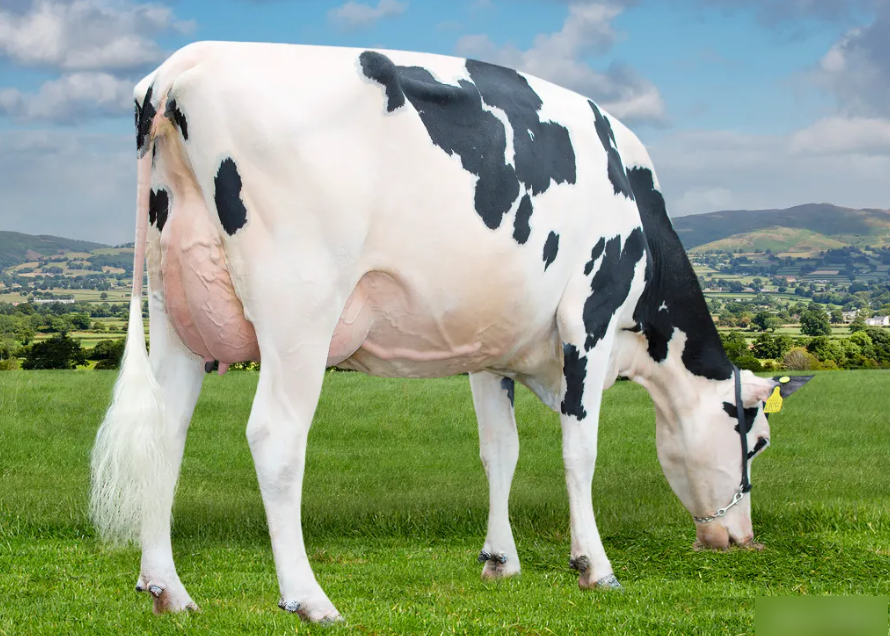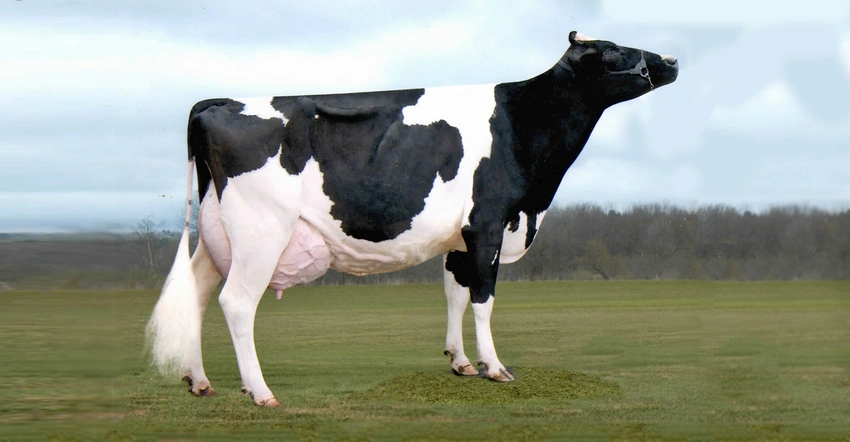Milk is the most valuable food in our diet, from this milk, we can make butter, yogurt, cheese, and many other dairy products that are loved by everyone from children to adults. The cow is considered the most important animal for giving milk. A typical dairy cow produces about 6 to 7 gallons of milk per day. If we take it every month, it is about 210 gallons per month. In a year, that totals about 2,555 gallons.
| Monthly: 7 gallons/day | 30 days = 210 gallons/month |
| Yearly: 7 gallons/day | 365 days = 2,555 gallons/year |

In terms of their lifespan, they are most productive in their first few years, with an average productive life of about 4-6 years. A cow can produce thousands of gallons of milk in its lifetime. It should be noted that these are only estimates and may vary depending on many factors such as race, health status, and care. Modern dairy farming consists of many different practices that ensure both cow health and maximum milk production.
How does a cow produce milk all the time?
Generally, people think that a cow gives milk throughout her life. However, this is a complete misconception. Just as other mammals give milk only when pregnant, a cow must be pregnant to produce milk. They continue to give milk for 2 years after calving. After that she must become pregnant again to give milk, otherwise she will not give milk without becoming pregnant.
The milk production process has several physiological stages. Cows eat food like grass and grains. Inside their tummies, there’s a special part that helps break down the food. The good stuff from the food goes into the cow’s udder, which is like a big milk-making factory. Inside the udder, certain cells use good food to make milk. This milk stays in the udder until it is time to come out. When the udder is full, a special reflex causes the muscles around the milk-producing cells to squeeze, and this pushes the milk out through the cow’s udder.
When we want milk, we use a machine or gently squeeze the milk by hand. This is how we get milk from cows – it’s like a team effort between the cow’s feed, her udder, and a little help from us!
Do Cows Need To Be Pregnant To Produce Milk?
There is no doubt that like humans and other mammals, pregnancy is the primary factor in milk production, but certain hormones also affect milk production. Hormonal changes during pregnancy stimulate the formation of mammary glands, which is the most important factor in milk production.
Generally, the ability to produce milk doesn’t only depend on pregnancy; it also depends on hormonal changes which are closely associated with mammary gland development and milk production.
How Much Milk Does a Holstein Produce Per Day?
Holsteins are also known as the highest milk-producing cows for their impressive milk production. The production can vary but average milk production is around 22,000 to 23,000 pounds per year, which is a satisfactory yield. Their average milk production is 9 gallons per day which is enough to make butter or cheese.
However, keep in mind that they require a lot of care, good breeding, and diet. Some factors like overall health management affect dairy performance and individual cows can produce different amounts of milk.

Why do farmers treat cows with antibiotics?
Farmers often treat the Diary cattle with antibiotics for:
- Treating Infections
- Preventing Spread of Disease
- After Calving
- Mastitis Control
- Surgery and Wound Care
When a cow gets a bacterial infection, antibiotics are used to kill the bacteria allowing the cow to recover from the disease. Antibiotics are also commonly applied prophylactically, particularly in stressful periods and in some cases when they are more susceptible to infections. This prevents the transmission of the diseases among the herd.
After calving, the cows may be more susceptible to the infections. Antibiotics can be used during the birthing process to prevent or treat infections. Milk quality may be affected by mastitis, which is an inflammation of the udder. Mastitis is treated and prevented from spreading within the udder using antibiotics. Open wound treatment is also done with antibiotics.
What happens to the calves in the dairy industry?
Replacement heifers:
The female calf is known as a heifer which is considered a substitute for dairy cows and hence they are reared for this purpose. They are raised on cattle farms and once they reach adulthood, they are ready to give milk and replace the older cows.
Bull calves:
Unfortunately, farmers consider male calves useless. They are often shot immediately after their birth or sent to veal farms. Some may be raised for beef production and may be kept on dairy farms or sold to other farms for that purpose.
Types of Dairy Cows
There are several breeds of dairy cows, each known for their specific characteristics and milk production abilities. Some of the best-known are:
Holstein: Holstein is the most common and widely recognized dairy breed. They are big black and white cows and are known for their high milk yield.
Jersey: Jersey cows are small cows, usually light brown with white faces. They are high in butter fat, making them ideal for butter and cheese.
Guernsey: Guernseys are medium-sized cows with red and white coats. They are known for their sweet and sour milk, rich in beta-carotene.
Ayrshire: Ayrshires are medium to large-sized cattle, generally with red and white coats. They are valued for their interchangeability and balance between milk production and components such as fat and protein.
Swiss brown: Swiss brown cows are larger and have distinctive brown or white coats. They produce milk with a balance of protein, butter, and fat, and are known for their long shelf life.
Little Milk Horn: Milkhorns come in a variety of colors including red, white, and roan. They are known for their dual purpose, providing better milk yield and better quality beef.
Dutch Belted: Dutch cowboys are easily identified by a dark, belt-like stripe in the middle of the white coat. They are a heritage known for their milk production and resilience.
Milk production Statistics
- An average Holstein cow produces 22,000 to 30,000 pounds of milk per lactation cycle. This production is influenced by factors such as genetics, nutrition, age, and overall health of the cow. 90% of dairy industries rely on their milk in the US.
- Global milk production: Around 275 million cows produce milk worldwide. If we talk about the US, there are 10 million dairy cows, 23 million in the European Union, and six to seven million in New Zealand and Australia.
- India is the leading country in milk production. America is the second largest producer of milk but New Zealand and Australia are mostly known for best quality and good milk.
- A genetically modified cow produces six to seven gallons of milk per day, but a normal cow produces one gallon of milk per day.
Interesting Facts
- Earlier, it used to take hours for a human to extract milk from a cow, but with modern technology, milk can be extracted within 10 minutes.
- Calves are born with a keen sense of smell. With the help of smell, they recognize their mother and can understand the surrounding environment.
- It takes twenty-two pounds of milk to make one pound of butter.
- The average weight of a dairy cattle is about 14 hundred pounds.
FAQs
How to increase milk in cows?
To increase milk production in cows, ensure regular feeding with high-quality forage, maintain a consistent feeding schedule, provide ideal living conditions, and also emphasize regular health check-ups. Additionally, use good milking techniques, minimize stress, and consider selective breeding for better genetics.
How long do dairy cows live?
Dairy cows typically live for about 20 years, although some can live longer with proper care. The lifespan can be influenced by factors such as genetics, health, and the management practices of the farm.
How much milk does a calf drink
The calf relies heavily on milk for its early growth and development. They consume about 2 to 4 quarts (2 to 4 liters) of milk per feeding and are fed several times a day. As the calf continues to grow, its milk supply can also increase significantly. Later, the calf will begin eating solid food as its primary source of nutrition.
The exact timing of this shift may vary based on the farming practices that are followed.
How much milk does a Jersey cow produce per day?
Jersey cows are known for having milk with high butterfat content, which is great for making dairy products like butter and cheese. They produce about 20 liters of milk per day and typically around 4 to 6 gallons of milk per day. Keep in mind that this can vary based on factors like the cow’s age, health, diet, and how well it’s taken care of.
On the other hand, a crossbred jersey cow produces 8 to 10 liters of milk per day.
How much water does a dairy cow drink per day?
A dairy cow typically drinks about 30 to 50 gallons (113 to 189 liters) of water per day, although individual water consumption can vary based on factors such as environmental conditions, diet, and stage of lactation.
How much does a dairy cow cost?
The price of a dairy cow can vary widely based on factors such as breed, age, health, and overall quality. On average, dairy cows can cost anywhere from a few hundred to a few thousand dollars. High-producing or pedigree dairy cows can command higher prices.
How many beef cows are in the US?
The number of cows in the United States in 2023 was 29 million, a number that may increase in the coming years.
How much grass does a cow eat per day in kg?
On average, a cow can consume about 2% to 3% of its body weight in forage per day, depending on factors such as size and nutritional requirements, consuming about 9 to 14 kg of grass per day. It is recommended to consult a veterinarian or nutritionist for exact feeding guidelines.
How much milk does a goat produce a day?
The amount of milk a goat produces per day can vary depending on the breed, the individual goat, and the stage of lactation. On average, a dairy goat can produce 1 to 3 liters (about 1 to 3 liters) of milk per day.
Conclusion
Dairy cows and especially whole Holsteins are very important for milk production and also contribute to the growth of any farm. If cows are well cared for, they can give milk throughout the year. They must then become pregnant again for the next lactic cycle. Better food rich with nutrients and clean water are key factors of high-yield milk production. Also, their positive environment contributes to their good health and fitness, giving them a long life.
Calves are valuable treasures in a dairy farm whether they are bulls or cows and both play an important role in the success of a dairy farm. Although the farmer focuses mostly on cows, bulls are also a good addition. That is, we can say that the foundation of an overall dairy farm depends on the cow and her healthy baby. Only in this way, we can get high-yield milk with excellent quality.

